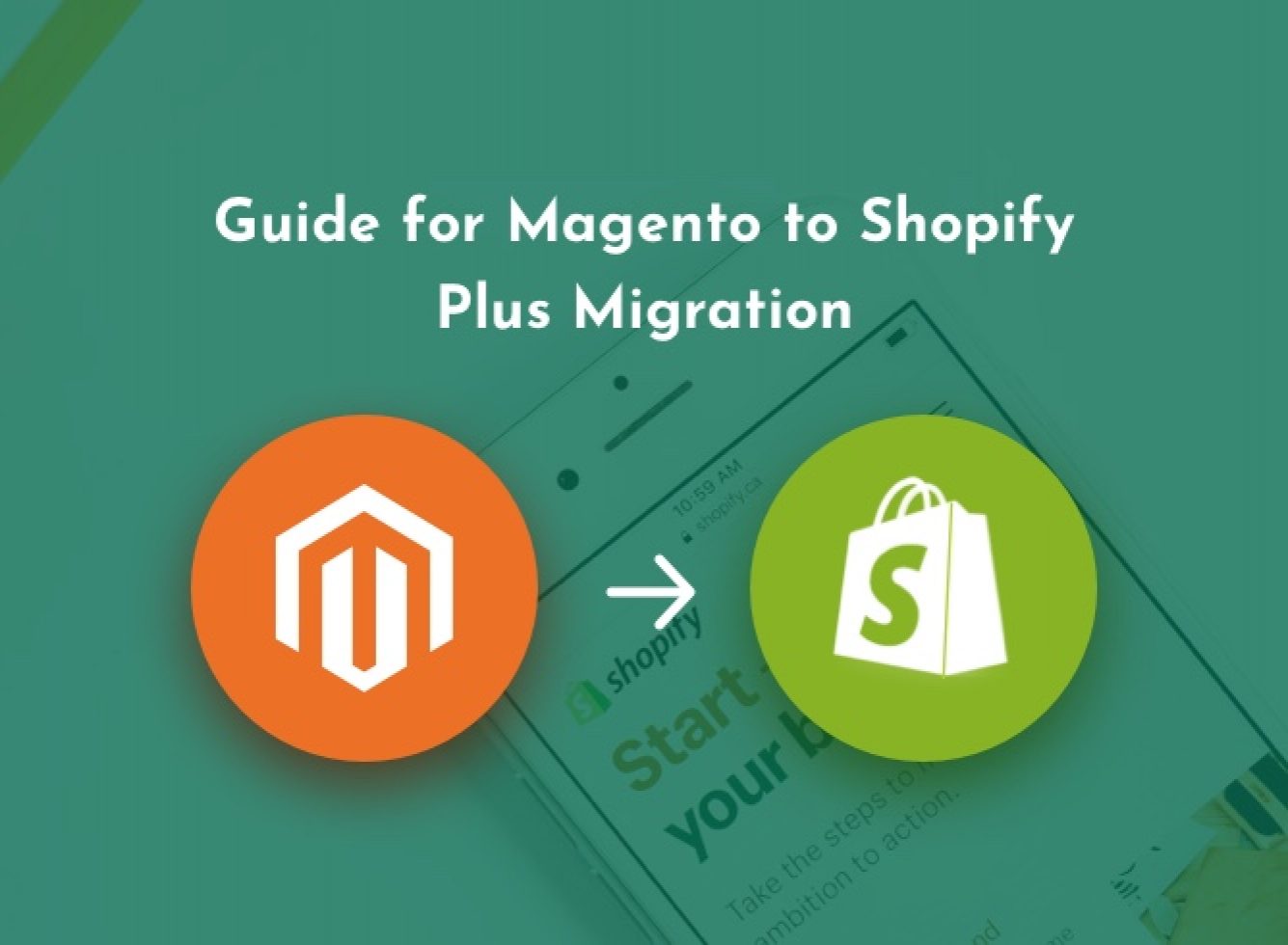An Expert Guide for Magento to Shopify Plus Migration

Moving from Magento to Shopify Plus is no mean feat in itself. The two platforms have many differences, which you should endeavour to fully understand before making the move. The following article breaks down the critical steps ecommerce store owners should take to ensure that vital elements like your customer data, products, and URLs are accurately transferred over to Shopify Plus.
How to Migrate Your Magento Store to Shopify Plus
Here’s what you must consider to ensure a successful Magento to Shopify Plus migration.
Defining the Approach
Before starting a migration project, it’s very important that you:
- Create a comprehensive list of requirements including the features and functionality required.
- Communicate with all key stakeholders regarding your needs and understand how Shopify Plus will meet them
- Shortlist agency partners that can demonstrate Magento to Shopify Plus migration experience
- Give the project the requisite level of time and resources to ensure as seamless a transition as possible
Exporting Data from Magento
In this step, you’re essentially transferring your data from Magento into spreadsheet format to enable Shopify to easily pick up the data during migration. To begin this transfer, follow the steps below:
- Go to the admin panel and click ‘System’, then ‘Data Transfer’, and finally ‘Export’.
- You’ll be met with three options — Products, Customer Main File, and Customer Addresses. Pick one at a time and repeat the process for all three to transfer the relevant data.
- Go to ‘Export File Format’ and if you’re using the Import Store App, select the ‘XML’ option. For other migration apps like Transporter for Shopify Plus, select the ‘CSV’ option. If you’d like to manually import data to Shopify also select the ‘CSV’ option.
Data Migration – Product Structure, Order & Customer Data
By this time, you’ll have already established how you’d like all the data stored against products, orders, and customers. The Shopify platform has default fields; however, any custom fields might need to be stored as metafields/tags, which are based on naming conventions for the website build.
Migration passwords over, while technically possible, shouldn’t be pursued. It poses a serious risk to the safety of sensitive customer data.
Perform a Content Audit
Perform a content audit to ensure that your new Shopify Plus website resembles the content on your old Magento store. This helps to ensure that you transfer the full list of product, category, and landing pages across to the new store. If you have a blog on your website, it’s often a great source of quality traffic, so a content audit means there’s less likelihood of a drop-off in SEO performance.
Pause Marketing Campaigns
Do you currently have any campaigns running? Are some scheduled for the near future? You’ll need to evaluate all your campaigns, regardless of channel, to ensure customers don’t end up on incorrect landing pages or 404 pages. This will increase your bounce rate and lose you lots of money on ad spend as well as missed conversion opportunities. Your campaign review should include email marketing, social media, paid search, and retargeting to name a few.
Notify Your Customers
It’s always best practice to notify your customers from as early on as possible when introducing changes — especially ones impacting the shopping experience. If this is not handled correctly and customers start facing unexpected challenges they didn’t have before, you’re likely to lose them to a company that more effectively meets their needs. Reach out to every customer and also make public announcements focusing on the benefits of the changes for customers together with relevant, simple instructions that will allow for an easier transition.
The Key Steps for Migrating to Shopify Plus
Follow the steps below to streamline the Magento to Shopify Plus migration process.
Ensure Shopify Plus is Right for You
While Shopify Plus is an excellent solution, it doesn’t automatically mean it’s the best option for your specific business. Take the time to weigh up the benefits against your needs, accounting for elements like security, hosting, updates, scalability, and costs before making your decision. Working with the right team can be invaluable to this decision-making process, which leads perfectly into the next step.
Work with Experienced Migration Professionals
Keep in mind that moving to Shopify Plus from Magento is not a straightforward process. It’s a complex project that requires expert knowledge, which factors in certain migration intricacies and the ability to identify potential problem areas.
That’s why it’s so important to do your due diligence and only hire migration specialists with demonstrable experience managing Magento to Shopify migrations. An ecommerce development agency like Vsourz has a team of professionals who will work with you every step of the way, ensuring you’re always fully informed on what’s happening with your project.
Create a Migration Strategy
Make sure that you have a migration strategy in place, especially if your online store is your main source of revenue. It’s the best way to oversee a friction-free migration and re-platforming process that poses minimal risk either during or after the transfer.
Backup Your Magento Store
It’s always better to be safe than sorry. Following this same principle, create a backup of your Magento store before starting the migration process, just in case anything goes wrong. It’ll mean you still have all your data and won’t have to begin from scratch again. Some Magento hosting companies provide automatic customer backups but if not, speak to your migration partner to ensure you conduct the backup accurately for your version of Magento.
Create a Shopify Plus Theme
One of the benefits of moving to Shopify is the unmatched design flexibility. It’s much easier to customise your store compared to Magento. You’ll have a range of free and paid themes to choose from with no requirement for coding. Additionally, all themes are mobile-responsive out of the box, allowing you to provide a consistent user experience for your customers across any device.
Develop an SEO Strategy
Negatively impacting your SEO rankings is one of the great fears of Magento to Shopify Plus migration. Make sure you are well-versed on how migrating can impact your performance on search engines like Google. There’s also the process of transferring metadata on top of the customer-facing end content that will need to be addressed.
Use 301 Redirects for URLs
Many URLs can change because of the move from Magento to Shopify. Implement 301 redirects to direct your old URLs to your new URLs so that site visitors don’t end up on the wrong pages. Within a few months search engines will re-index the new website, thus replacing the old URLs in organic results.
Migrate Data
Migrate all the relevant data including products, orders, customers, and website content to your new Shopify Plus store. Your chosen Shopify Plus development agency will assist you with this to ensure a seamless transfer.
Add Essential Integrations
Sometimes you’ll need to integrate your existing solutions with third-party systems like ERP solutions, accounting software, or CRM systems to enhance your business performance. There are often existing apps for these integrations but there’ll be times when you’ll need to build out these connections from scratch. An experienced Shopify Plus developer comes in handy again here.
Launch
Plan ahead for the launch of your new store. Leverage the benefits of A/B testing to optimise your new store and minimise the risk of losing traffic during your transition from Magento to Shopify Plus. It’s also important to install analytics and closely monitor your post-launch performance. That way it’s easier to make adjustments as needed.
Conduct an Audit After Migration
After completing the migration, conduct another audit. This ensures you’ve transferred everything across correctly and there are no crawl errors or usability problems. You’ll find this information on platforms like Google Search Console and Bing Webmaster Tools. In addition to this, check that there are missing products and site navigation issues among other problems you’ll need to address post-migration.
Magento to Shopify Plus Migration Done Right with Vsourz
Migrating from one platform to another is a complex process with many moving parts. It requires expert technical know-how to ensure a seamless transition that doesn’t cost your ecommerce business unnecessary extra time or money. For that reason, it’s in your best interest to work with migration specialists like Vsourz for a stress-free move from Magento to Shopify Plus.






